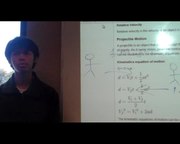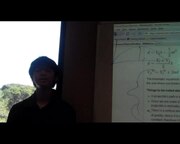Mechanics
Mechanics is the branch of physics concerned with the motion of objects under the influence of forces.
Contents
Motion
Motion can be described as:
- distance/displacement
- speed/velocity
- acceleration
Distance and speed are scalar quantities, therefore they only describe the size of the motion. Displacement, velocity and acceleration are vector quantities, therefore they describe both the size and direction of the motion.
Distance and Displacement
Distance is the total length an object has moved, while displacement is the length and direction between the start point and the end point of the object's motion.
eg. An object has moved 2m North from point A to point B, then 2m East to point C, then 2m south to point D, then 2m west back to point A. The distance the object has travelled is 8m, but its displacement would be 0m, since it started and ended at point A.
Distance and displacement are both have the symbol "d" and are measured in metres, m.
Speed and Velocity
speed is the rate of change of distance, or simply put, it is how fast an object is travelling. Velocity is speed but with direction. \
[math]velocity, v=\frac{Change In Displacement}{Change In Time}=\frac{\Delta d}{\Delta t}[/math]
Speed and velocity are measured in metres per second, m s-1
Acceleration
Acceleration is the rate of change in velocity.
[math]acceleration, a =\frac{Change In Velocity}{Change In Time}=\frac{\Delta v}{\Delta t}[/math]
Acceleration is measured in metres per second squared, m s-2.
Relative Velocity
Relative velocity is the velocity of an object in relation to another object.
Projectile Motion
A projectile is an object that moves through the air without its own source of power and is only under the influence of gravity. As it name states, projectile motion is the path that a projectile follows in the Earth's atmosphere and can be modelled by the kinematic equations of motion.
Kinematics equation of motion
Vf = Vi + at
[math]d = V_{i}t + \frac{1}{2}at^{2}[/math]
[math]d = V_{f}t - \frac{1}{2}at^{2}[/math]
[math]d = \frac{V_{i} + V_{f}}{2}t[/math]
[math]{V_{f}}^{2} = {V_{i}}^{2} + 2ad[/math]
The kinematic equations of motion can be used to find missing variables. Remember to choose the right equation, the one where you know all the values for the variables except for the one you are looking for.
Things to be noted about projectile motion:
- A projectile's path is always a parabola, since we are disregarding air resistance.
- Since we are under Earth's gravity, the acceleration will always be 9.81 m s-2. This value is negative if the projectile is vertically going up, and is positive if the projectile is going down.
- There is a vertical and horizontal component. The vertical component of the projectile is always under the effect of gravity, hence it is either constantly accelerating/decelerating at 9.81 m s-2. The horizontal velocity is constant, therefore it has no acceleration.
- At the maximum height of the motion, the vertical component of the projectile's velocity is zero.
- The total time of the projectile's flight is twice the time it took to reach maximum height.
- The range (distance travelled horizontally) is the horizontal velocity multiplied by total time of flight.
- The projectile hits the ground at the same angle and speed as it was fired, given that the ground is level.
Circular Motion
A revolution is motion once around a circle. Period, symbol t, is the time taken for one revolution.
The distance travelled in one revolution is equal to the circle's circumference, hence d = 2πr.
The velocity of the object is then calculated by [math]v = \frac{d}{t}[/math]
Centripetal Force
When an object is being moved around in a circle by a string, forces are acting on it. Tension in the string pulls the ball inward, and is at a right angle to the ball's motion. This tension is called the Centripetal Force, heading towards the centre of the circle. Since force is F = ma , the ball must be accelerating towards the centre. The ball acceleration can be calculated by: [math]a_{c} = \frac{v^{2}}{r}[/math]
where ac is the centripetal acceleration, v is the ball's speed in m s-2 and r is the radius of the circle in metres.
By substituting the centripetal acceleration in the equation for force, the centripetal force would be: [math]F_{c} = \frac{mv^{2}}{r}[/math]

